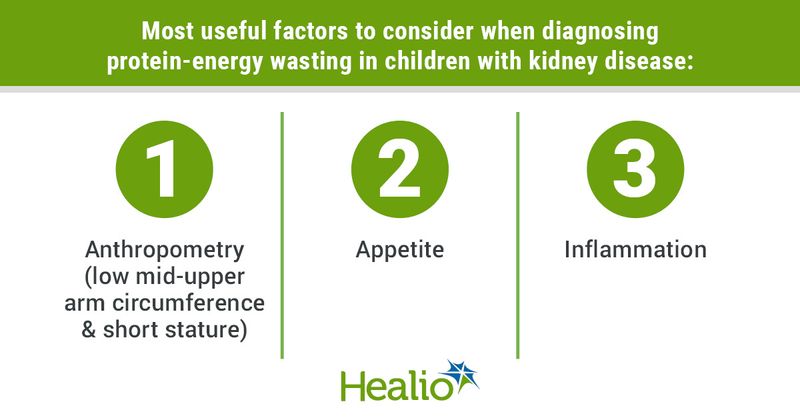Research provides ways to diagnose protein-energy wasting in children with kidney disease
Finding that protein-energy wasting was prevalent in children with kidney disease, researchers outlined what they deemed to be the “most useful” methods for making accurate diagnoses of the condition in this patient population.
“Chronic kidney disease (CKD) in children carries the burden of undernutrition and growth retardation, which is associated with significant morbidity and mortality,” Arpana Iyengar, MD, DNB, FPN, FRCP, of the department of pediatric nephrology at St. John’s National Academy of Health Sciences in Bangalore, India, and colleagues wrote. “In contrast to protein-energy malnutrition, undernutrition in a uremic milieu is governed by a complex interplay of factors — decreased appetite, increased metabolic rate, increased energy expenditure, inflammation, comorbidities, dialysis therapies and suboptimal response to adequate nutrient intake. Therefore, it becomes pertinent to include all pathogenic factors besides just nutrient intake to describe and define this nutritional comorbidity of CKD.”

Iyengar and colleagues pointed out that criteria put forth by the International Society of Renal Nutrition and Metabolism to diagnose protein-energy wasting (PEW) in adults differs from that used for a diagnosis in children.
“These pediatric criteria included parameters that were not considered in the adult PEW criteria,” the researchers explained. “Appetite replaced dietary intake; serum transferrin and [C-reactive protein] CRP were introduced under biochemical parameters, and short stature was an additional parameter included to reflect status of growth in children.”
Similar to adults, anthropometry parameters (such as reduced BMI and reduced muscle mass) and biochemical measures (such as serum albumin and cholesterol) are also used for children, according to the researchers.
Arguing that there is a scarcity of research on PEW in children with CKD or end-stage kidney disease — especially those from “low middle-income countries” — Iyengar and colleagues recruited 123 participants (73 had CKD stages 2 to 4; 50 had ESKD). They assessed PEW based on the following: BMI for height, mid-upper arm circumference, height for age, appetite, serum albumin, cholesterol, transferrin and CRP.
In total, 58% of the study cohort had PEW (47% of those with CKD vs. 73% of those with ESKD). PEW was especially common in the group of children with ESKD, as it was present in all of those on hemodialysis and in 74% of those on peritoneal dialysis.
Regarding specific measures, anthropometry and appetite provided the most accurate means to diagnose PEW, with researchers noting, “the role of biochemical measures was very limited.”
Based on their findings, Iyengar and colleagues suggested a combination of low mid-upper arm circumference, short stature, reduced appetite and high CRP should be considered because these were the most common parameters fulfilled by the children who were diagnosed with PEW.
“Children with CKD and those on dialysis are vulnerable to PEW,” the researchers concluded. “There has been no clear consensus on the approach to diagnosing pediatric PEW in clinical practice compared to adults. The observations from this study reveal that exclusive criteria may be needed to diagnosis PEW in children with CKD and ESKD based on [three] factors — anthropometry, appetite and inflammation.”

